Physical Address
304 North Cardinal St.
Dorchester Center, MA 02124
Revision rhinoplasty is the process of correcting secondary deformities from primary surgery.
Skin thickness must be analyzed and factored into decision making in revision rhinoplasty.
Thin skin–soft tissue envelope (SSTE) contracts with time and can reveal minor irregularities.
Thick SSTE must have adequate structure projected into the SSTE to prevent long-term complications with supratip fullness.
Costal cartilage quality varies with calcification and age.
Sequential sculpting of costal cartilage intraoperatively allows warping tendencies to be identified and predicted for best long-term result.
A systematic analysis and approach to revision rhinoplasty is paramount to success.
Revision rhinoplasty is considered to be among the most difficult and challenging operations for plastic surgeons. The difficulty in rhinoplasty lies in the understanding of the three-dimensional configuration of the osseocartilaginous framework and its translation into external contour; minor rhinoplasty maneuvers may lead to significant contour deformities and functional problems if not executed properly. To perform revision rhinoplasty, a thorough understanding of nasal anatomy and function is crucial. Realistic expectations have to be set with the patient in a comprehensive preoperative consultation. Owing to significant structural damage, revision rhinoplasty frequently becomes a reconstructive operation rather than an operation of minor adjustments.
The initial patient consultation is critical in determining a patient's candidacy for revision surgery, to assess both the difficulty of the operation and the patient's expectations. Many revision patients are more knowledgeable and demanding of the result and the surgeon's time. In general the expectations can be dramatically higher. Setting realistic surgical goals with the patient is critical, as patients must understand the limitations of secondary surgery due to underlying structural damage and scarring.
Preoperative evaluation should include:
Assessment of patient goals
Surgeon review of prior records and operative reports
Comprehensive medical and surgical history
History of bleeding disorders or coagulopathy
Previous surgical history
Active tobacco and alcohol use, as this may compromise the postoperative result
Previous placement of alloplastic implants and composition of the implant
History of filler injection to the nose or face, as these may significantly alter surgical anatomy and compromise vascularity
Preoperative photography and computer imaging
Standard rhinoplasty photography should be performed, including frontal, oblique, lateral, and base views; close-up frontal, lateral, and oblique views are helpful as well.
Computer imaging is often essential for patients to garner a reasonable expectation for results following surgery. The surgeon must be careful to provide a reasonable expectation postoperatively, and it is important to discuss the limitations of computer imaging, especially in the nasal tip and dorsum. Computer imaging should be used primarily as a teaching tool rather than a predictive one.
Discussion and evaluation of functional considerations
The NOSE survey is a powerful adjunct and can be used to track long-term results after surgery.
Surgical consent
At the conclusion of the patient interaction, a robust surgical consent should be obtained and, in revision surgery, must be inclusive of all possible intraoperative needs.
Following the patient interview, a robust physical examination should be performed that can then lead toward discussion of revision surgery and expectations.
A thorough and systematic physical examination with accurate diagnosis is critical to the success of the operation. The general shape, horizontal thirds, and vertical fifths of the face should be analyzed. Global assessment of nasal deformities in context with the remaining facial features often shows one or two readily noticeable problem areas. These deformities should ultimately be prioritized during surgery, as modification of any nasal structure influences the appearance of other structures; that is, a given structure is modified based on the status of its neighboring structure.
Specific to the external and intranasal examination of the nose, the following should be noted and documented:
Skin thickness
Thin skin
Thin skin can be very problematic if not approached properly.
Most minor irregularities in the structural framework of the nose will show over time as the skin–soft tissue envelope (SSTE) contracts.
Specific maneuvers must be taken during surgery to prevent long-term complications in a thin-skinned nose.
Thick skin
While thick skin will conceal minor irregularities of the skin, prolonged postoperative edema may result, which must be predicted. The patient must be counseled on this preoperatively.
Thicker-skinned patients require the cartilaginous framework to project into the SSTE to provide definition to the nose; otherwise, significant scarring may occur in dead space, exacerbating SSTE thickness. This can ultimately lead to an amorphous, unrefined appearance or pollybeak deformity.
Skin quality and scarring
Existing scars should be noted and, if possible, corrected during surgery.
Patients who have undergone previous rhinoplasty may have thinned, damaged, or devascularized SSTE.
Extensive dissection and electrocautery should be kept to a minimum in such patients to decrease the risk of ischemia and soft tissue necrosis.
Shortage of vestibular lining or vestibular stenosis should be noted on the preoperative visit. This may require auricular composite grafts for tension-free closure so as not to distort the alar margin.
Assessment of the upper, middle, and lower thirds of the nose
The nose should be systematically inspected for width, deviation, irregularities, and asymmetries.
Palpation is important to assess the nasal skeleton for shape, strength, and symmetry, as well as resistance and recoil of the tip and SSTE.
Upper one-third of the nose should be particularly inspected for nasal bone length, deviation, and the need for any dorsal augmentation.
Middle one-third of the nose contains the middle nasal vault, which can be pinched and deviated. This must be noted preoperatively to prevent potential pitfalls with nasal obstruction.
Lower one-third evaluation should note the presence of supra-alar pinching, tip support, nostril retraction, and the alar-columellar relationship. These factors play a significant role in cosmesis and function and must be addressed for a satisfactory outcome. The caudal septum should be palpated to assess position and integrity.
Aesthetic evaluation
Frontal view
The brow-tip aesthetic line should be a subtle, hourglass-shaped curvilinear line between the medial brow and nasal tip. It should follow a pattern of relative width at the bony vault with a slight narrowing at the middle vault and relative width again at the nasal tip.
The transition from the columella to the alar margins should have a gentle “gull-in-flight” configuration.
Base view
The nasal base should have a triangular shape without pinching or concavities between the tip and alar lobules.
The surgeon should note the presence of alar pinching, notching, tip irregularities, and caudal septal deviation.
Short medial crural footplates will present as excessive flaring of the columella toward the base and may require correction.
Lateral view
The dorsum is assessed for smoothness, contour, position of the radix, and the starting point of the nose.
The tip is analyzed for projection, rotation, nasal length, nasolabial angle, presence/absence of supratip break, and presence/absence of the double break (columellar-lobular angle).
Tip projection can be specifically analyzed using Goode's method:
Nasal tip projection—the distance from the alar crease to the tip-defining point—should approximate 55% to 60% of the nasal length—measured from the nasal starting point near the superior palpebral fold to the tip-defining point.
The nasolabial angle also must be assessed; an ideal nasolabial angle ranges from 90 to 95 degrees in men and 95 to 110 degrees in women.
Intranasal examination
Both anterior rhinoscopy and rigid nasal endoscopy should be performed for an adequate examination of the turbinates, septum, internal nasal valve (INV), and nasal vestibule.
Specific attention should be paid to the nasal vestibule in revision surgery, as significant scarring at the INV can be present due to excessive tension in previous closure or inadequately closed incisions.
Presence of residual septal deviation is common and often contributes to deformity. Inferior turbinate hypertrophy or overreduction should be noted, along with the quality of the mucosa and presence of synechiae.
A modified Cottle maneuver is performed, placing an instrument underneath the lateral nasal side wall to assess for nasal valve patency and symptomatic improvement in obstruction. Improvement denotes a dynamic collapse that may be improved by strengthening the sidewall with alar batten grafts or lateral crural strut grafts (LCSG).
The surgical approach should cater to the deformity and goals of reconstruction. The external approach is most frequently utilized for its superior exposure and opportunity for precise graft placement with suture fixation, particularly in complex deformities.
The external approach combines bilateral marginal incisions with a transcolumellar incision.
At the start of the operation, external contour irregularities and deformities should be marked, as injection of anesthetic agent can distort or camouflage these irregularities.
Prior to making incisions, an ample amount of local anesthetic is used for hemostasis, and hydrodissection of scar tissue from the skin and soft tissue envelope.
Transcolumellar incision
In cases of prior external rhinoplasty, the same columellar incisions should be used.
If deprojection of the nasal tip is planned, the columellar incision may be placed slightly above the scar. This allows for scar excision at the conclusion of the procedure if skin redundancy is present.
In cases where re-projection is anticipated, it is often difficult to excise the scar due to the need for additional skin and soft tissue.
As the SSTE is raised from the underlying cartilaginous framework, care must be taken to avoid damage to the overlying skin in areas of severe contracture. This is sometimes assisted by additional hydrodissection.
In patients with minor contour deformities, the endonasal approach using marginal or intercartilaginous incisions can be an excellent option. Proponents of the endonasal approach cite lower morbidity and quicker recovery, though it is more difficult to correct major deformities. If structural deformity is not corrected, this can lead to further contracture and deformity over time, which may lead to another revision surgery.
Structural rhinoplasty requires additional grafting material. Septal cartilage is usually abundant in the primary setting and sometimes in the revision setting depending on the technique of the previous surgeon. However, in most cases, the septal cartilage has been removed and additional grafting material is required. Several options are available for grafting material, including residual septal cartilage, costal cartilage (irradiated or autologous), auricular cartilage, calvarial bone, and alloplasts.
In general septal cartilage is preferred to other grafting materials due to ease of harvest, low morbidity, and favorable characteristics. Septal cartilage is easy to sculpt, provides adequate structural support for most grafting purposes, has a low rate of resorption, and does not warp.
However, in most revision cases, septal cartilage has often been resected. To assess availability of septal cartilage, the surgeon may review previous operative reports or rhinoplasty diagrams and palpate the nasal septum with a 25 g needle.
Septal cartilage can be harvested via a Killian incision, hemitransfixion incision or an external rhinoplasty approach after dissection between the medial crura. The Killian incision is placed at the junction of the nasal mucosa and vestibular skin. It is useful in cases of septal deviation confined to the middle and/or posterior one-third of the nasal passage. One disadvantage is that the caudal margin of the nasal septum is inaccessible.
Hemitransfixion incisions are placed at the caudal margin of the nasal septum, as determined by visualization and palpation. The major advantage over the Killian incision is access to the caudal margin of the nasal septum. Regardless of the approach used, a 15 mm dorsal-caudal L-strut must be maintained for structural support.
Costal cartilage may be autologous or homologous (irradiated cadaveric) and is often the preferred grafting material in revision rhinoplasty when septal cartilage is insufficient or structurally weakened. Its advantages include abundant availability, strong, structural support, and decreased risk of infection or extrusion in comparison to alloplasts. Disadvantages include donor site morbidity, postoperative pain/discomfort, pneumothorax, prolonged surgical time (primarily due to graft preparation, placement, and refinement, rather than graft harvest), and warping of cartilage. Careful decisions should be made toward choosing segments of cartilage and predicting warping; splinting of the grafts with slivers of cartilage is often necessary to prevent excessive warping.
The ideal age range for costal cartilage grafting is 30 to 50 years. Younger patients tend to have softer costal cartilage, which makes harvesting and carving easier but is at risk for increased warping ( Figs. 34.1 and 34.2 ). Older patients tend to have more calcification in the rib, which makes the cartilage more brittle. This can lead to higher risk of fracture with manipulation but the tissue tends to warp less. The calcifications within the cartilage produce some brown discoloration ( Fig. 34.3 ).
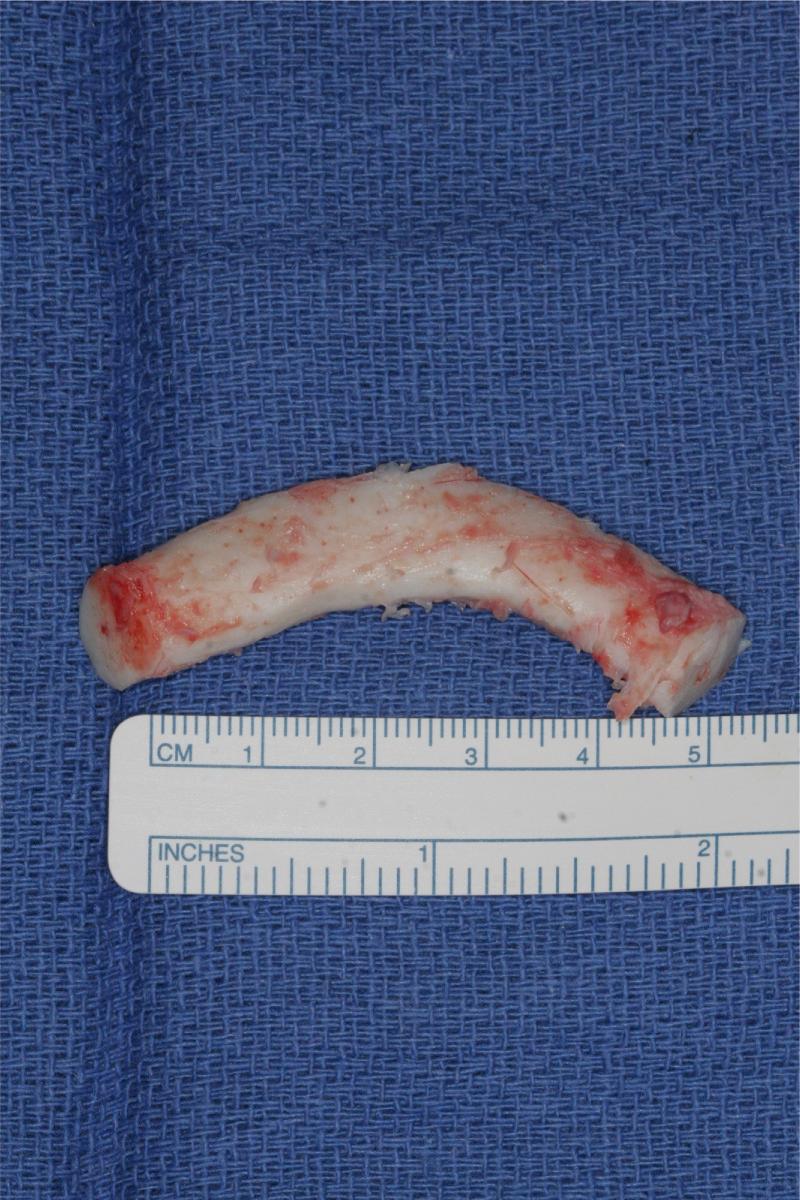
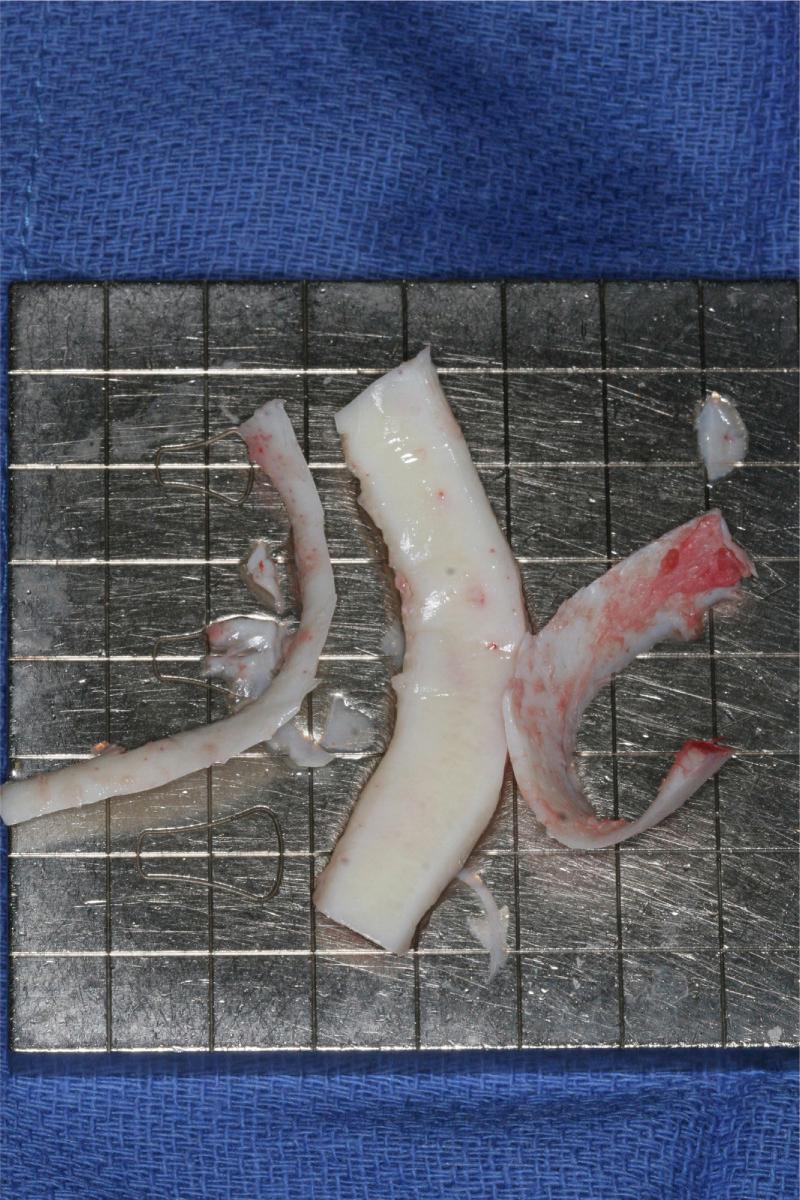
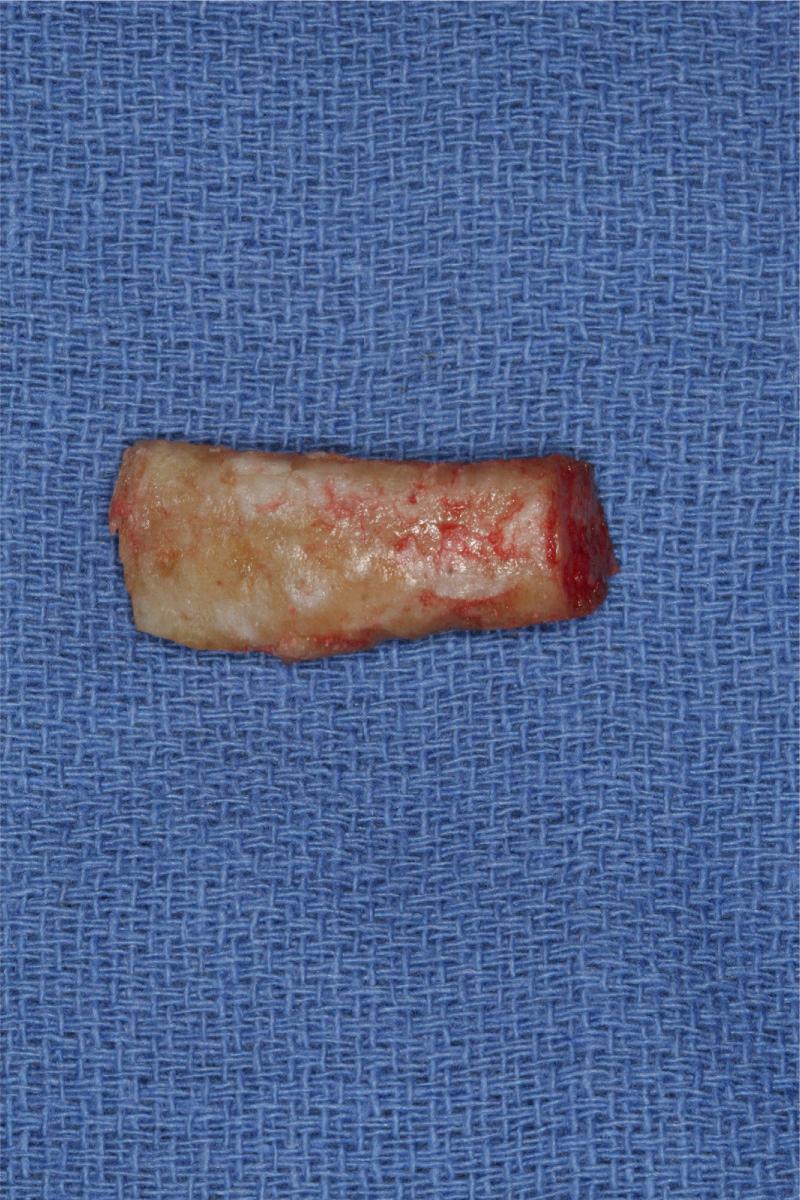
In harvesting costal cartilage, perichondrium can be harvested as well, which can be invaluable in revision rhinoplasty ( Fig. 34.4 ). It can be used as soft tissue onlay grafts or as an underlay graft for dorsal augmentation to allow for rigid fixation to the nasal bones.
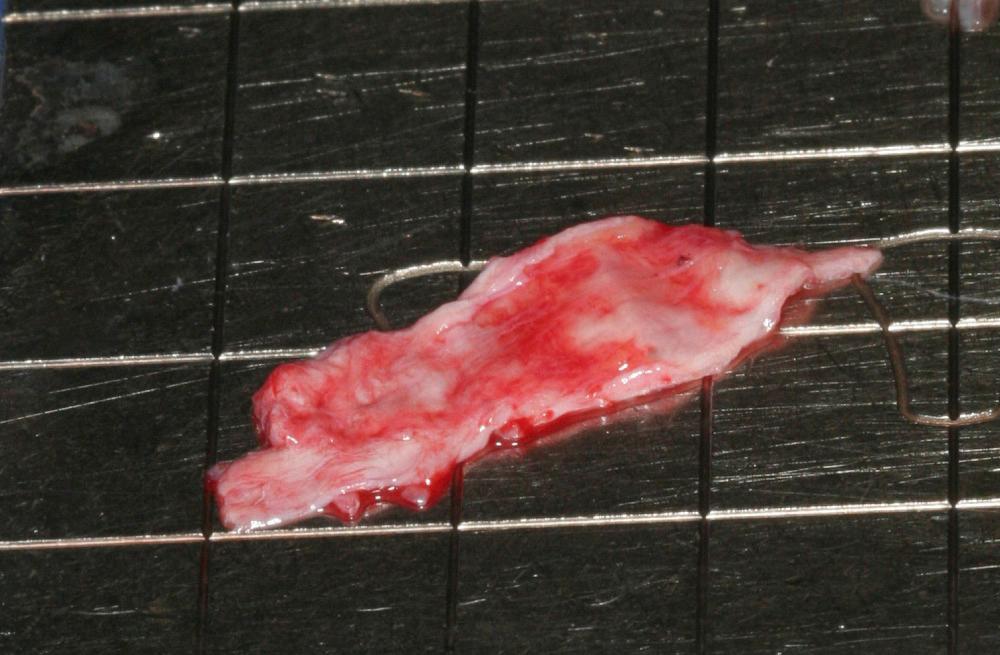
Once the graft is harvested from the chest, the segment of rib is carved into three longitudinal segments with varying thickness depending on the types of grafts needed. Each segment is initially thinned, soaked in a saline solution, and observed for warping while the operation continues. Carving in this manner will allow for warping tendencies to manifest, and the grafts can be splinted as needed prior to implantation in the patient ( Fig. 34.5 ). Homologous cadaveric rib cartilage may be used instead of autologous cartilage. The primary advantage lies in the absence of donor site morbidity and decreased surgical time. Availability is frequently limited in certain geographic areas and typically can be expensive. True neovascularization of implanted cadaveric rib has yet to be shown, and though studies have shown minimal resorption rates, the concern remains that in the long term, cadaveric rib may have higher resorption rates than its autologous counterpart.
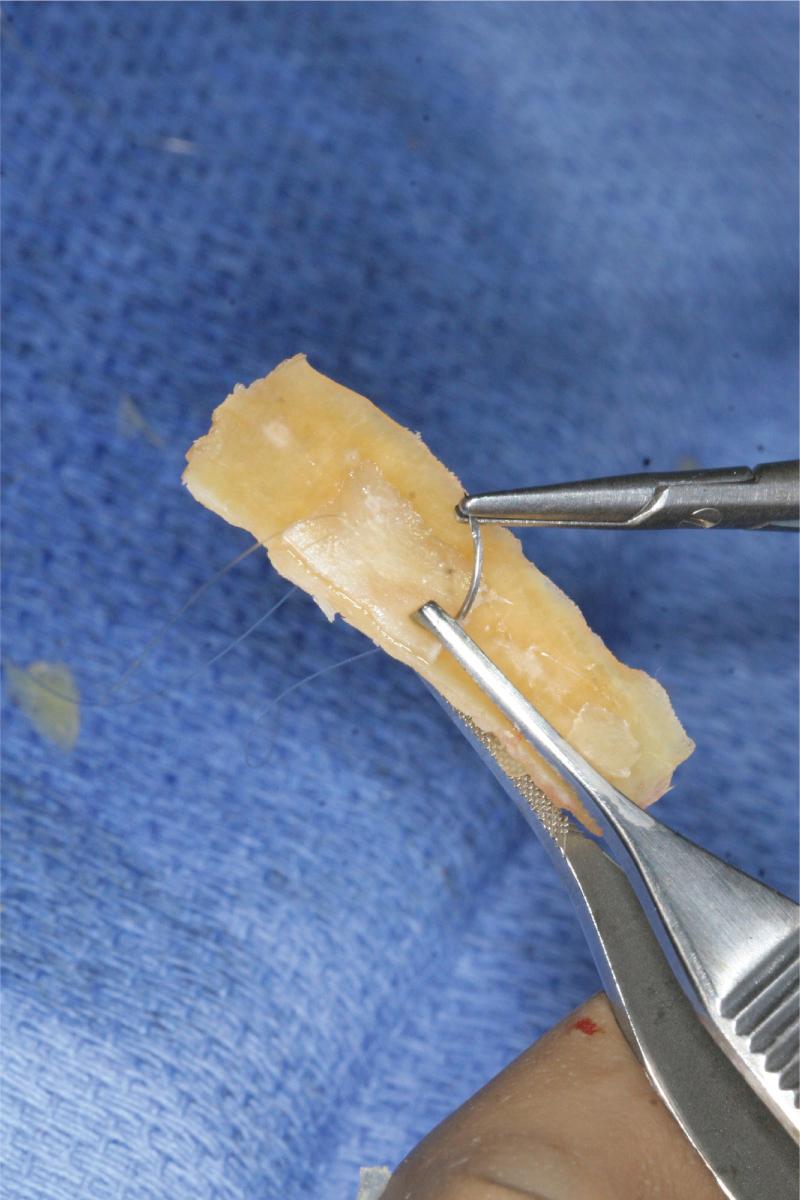
Auricular cartilage is a viable alternative grafting material when (1) septal cartilage is not available, (2) only a small amount of grafting material is necessary, (3) the graft does not need to provide major structural support, and (4) costal cartilage is not viable due to excessive calcification.
Auricular cartilage is considered inferior to other grafting materials because of its inherent curvature, structural weakness, and donor site discomfort.
The postauricular approach has decreased morbidity and superior scar concealment in comparison to the anterior approach. The entire conchal cartilage—both cavum and cymba conchae—can be removed with minimal change to auricular shape. It is preferable to keep the cavum concha of the ear for potential composite skin/cartilage grafts used for alar retraction and deficiencies in vestibular lining.
The risks of conchal cartilage harvest are minor but the most important for patient consent include ear displacement closer to the head and palpable abnormalities to the ear and minor contour changes. After harvest, a bolster should be placed to prevent auricular hematoma.
Calvarial bone grafts may be used for certain aspects of nasal reconstruction, namely dorsal augmentation. Grafting is otherwise limited by excessive rigidity. Split calvarial bone grafts are harvested from the outer table of the parietal skull and can be harvested in large quantities. Donor site morbidity is limited if meticulous technique is used, but postoperative pain is the most frequent complaint.
Disadvantages of calvarial bone grafts include donor site morbidity, prolonged surgical time (primarily related to harvest as well as graft preparation with drilling or screwing techniques to secure grafts), unnatural stiffness in the nose, which sometimes may cause discomfort, and calvarial bone graft resorption.
Alloplastic implants are becoming increasingly popular in both primary and revision rhinoplasty, particularly in Asian countries. The ease of placement and lack of donor site morbidity make alloplasts an attractive option to many surgeons; however, the disadvantages can be significant.
These grafts comprise a variety of materials:
Porous polyethylene
Owing to its biointegration, porous polyethylene grafts are very difficult to remove and typically leave extreme fibrosis in the nasal tissues. This can significantly complicate revision surgery and oftentimes may cause irreversible damage to the SSTE.
The infection rate has been reported at approximately 3.1% in a previous meta-analysis.
Silicone
Can be produced in almost any consistency, is easily carved, and easily removed due to capsule formation.
There are significant drawbacks with reported extrusion rate of 8% at 160 days with increasing rates of extrusion that are reportedly lifelong.
Polytetrafluoroethylene (PTFE) and expanded PTFE
Expanded PTFE is composed of small pores and permits vascular ingrowth similar to porous polyethylene.
Reported complication rates range from a 0.4% to 10.6% infection rate.
Become a Clinical Tree membership for Full access and enjoy Unlimited articles
If you are a member. Log in here